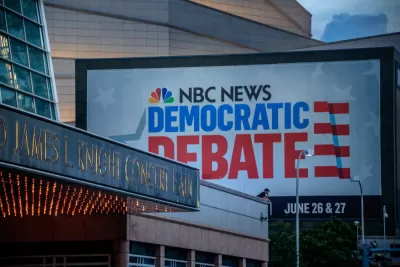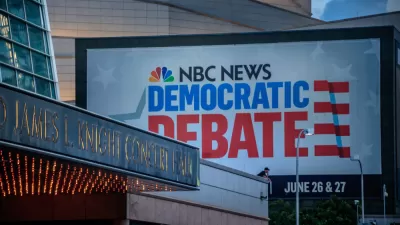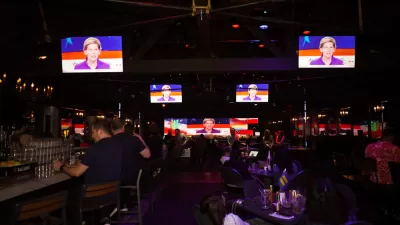Candidates drop names for a reason.

Despite campaign platforms and media coverage that have focused with unprecedented intensity on matters related to the built and natural environments, last week's Democrat Candidate debates featured only one signature moment that addressed urban policies: the tit-for-tat between Senator Kamala Harris and former Vice President Joe Biden over bussing policies in Berkeley, California, which has been widely discussed in the media since the debates.
Laura Bliss writes for CityLab to document the other, less ballyhooed mentions of urban policy and specific local contexts throughout the two-day debate event.
Bliss prefaces this analysis with an interesting idea about the way candidates use references to local and regional signifiers to build credibility and recognition with the audience:
On a presidential debate stage, place matters. With a slew of candidates jockeying for breakout moments and, in many cases, introducing themselves to a national audience for the first time, regional identifiers are one of the best sorting mechanisms voters get. But presidential aspirants must balance playing up their hometown roots to tell stories and display their relatability with the need to make sweeping gestures toward national reconciliation. Many reeled off campaign stops to build credibility with unfamiliar regions. Some places appeared as political touchstones, like the locations of recent mass shootings, or synecdoches like “Washington” and “Wall Street.” Certain candidates repeatedly highlighted geography as destiny—but it may be just as telling who abandoned their atlases.
The article includes a map of the specific place references that also indicates the candidates' hometowns, as well as a map of worldwide locations referenced by the candidates. The bulk of the article is devoted to each reference by candidates of specific locations and policies that affect communities.
Under the criteria for the next round of debates, scheduled for July, only 14 of the current candidates would qualify, so the sample size of opinion on matters involving cities from the Democratic candidates for president is bound to start shrinking, and soon. The criteria get even more stringent in September.
FULL STORY: We Mapped Every Place Mentioned by the Democratic Candidates

Alabama: Trump Terminates Settlements for Black Communities Harmed By Raw Sewage
Trump deemed the landmark civil rights agreement “illegal DEI and environmental justice policy.”

Study: Maui’s Plan to Convert Vacation Rentals to Long-Term Housing Could Cause Nearly $1 Billion Economic Loss
The plan would reduce visitor accommodation by 25% resulting in 1,900 jobs lost.

Why Should We Subsidize Public Transportation?
Many public transit agencies face financial stress due to rising costs, declining fare revenue, and declining subsidies. Transit advocates must provide a strong business case for increasing public transit funding.

Wind Energy on the Rise Despite Federal Policy Reversal
The Trump administration is revoking federal support for renewable energy, but demand for new projects continues unabated.

Passengers Flock to Caltrain After Electrification
The new electric trains are running faster and more reliably, leading to strong ridership growth on the Bay Area rail system.

Texas Churches Rally Behind ‘Yes in God’s Back Yard’ Legislation
Religious leaders want the state to reduce zoning regulations to streamline leasing church-owned land to housing developers.
Urban Design for Planners 1: Software Tools
This six-course series explores essential urban design concepts using open source software and equips planners with the tools they need to participate fully in the urban design process.
Planning for Universal Design
Learn the tools for implementing Universal Design in planning regulations.
Caltrans
Smith Gee Studio
Institute for Housing and Urban Development Studies (IHS)
City of Grandview
Harvard GSD Executive Education
Toledo-Lucas County Plan Commissions
Salt Lake City
NYU Wagner Graduate School of Public Service





























